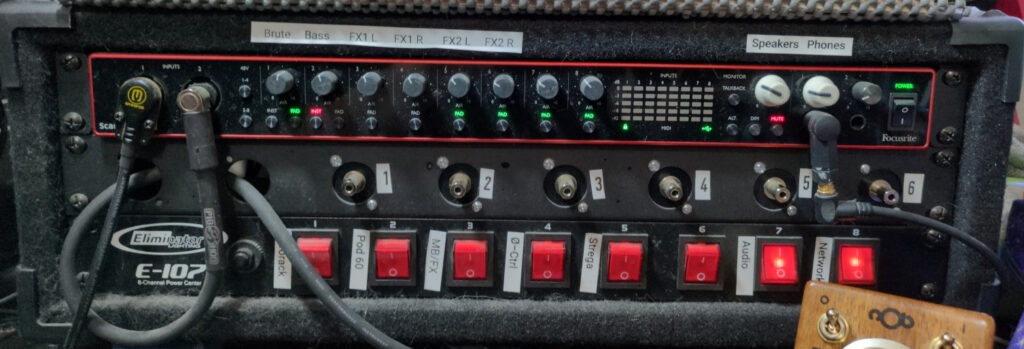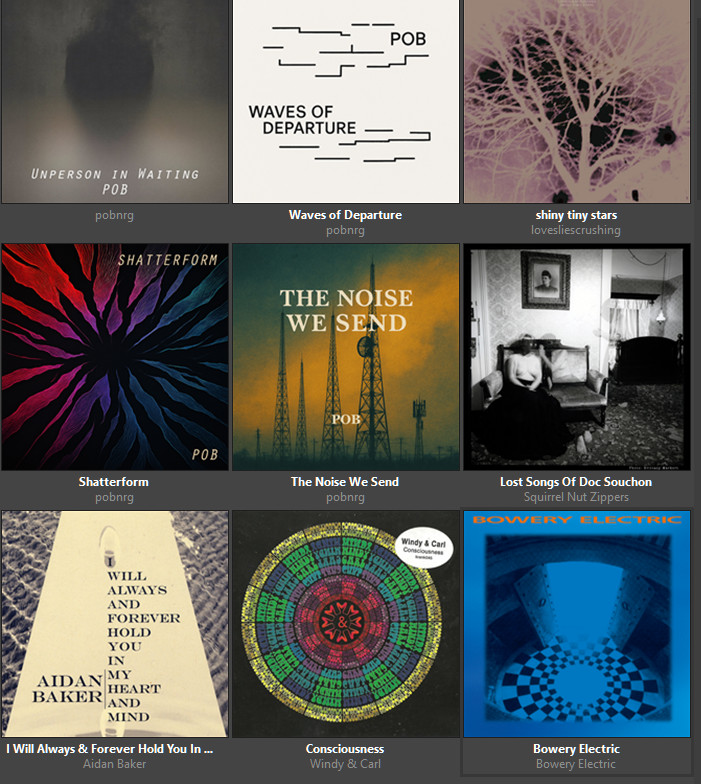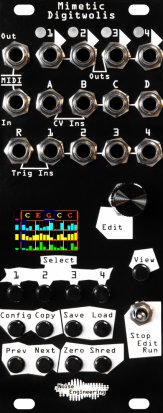I did this back in November 2018, and it’s time for an update. It feels extra appropriate to start this during KnobCon weekend when many people would have just been looking at a bunch of gear anyway.
My studio is still an L-shaped corner desk, with the long side to my left. There’s a printer, then a shelf of random supplies with my patch cable holder mounted to that. Since people have opinions about cables: I use Modular Addict stackable & skinny cables, one color per length. They’re cheap, reliable, slim, and hang straight from the rack. I’ve tried other kinds, but this is what I have stayed with.
In front of that, a foam wedge serves as a mini pedalboard. The pedals are:
- OBNE Dark Star V3 (stereo), in blue. It’s my most recent hardware acquisition. The reverb itself is super long and ambient but honestly nothing special; it’s the lo-fi pitch shifters, crush/drive, filter, and the feedback response that make it more interesting. To be honest, I don’t know if this will be a long-term keeper or if the novelty will wear off, but I’m enjoying it so far.
- Walrus Audio Slöer, also blue. While is specializes in ambient reverb, so do I, and I feel like I can run anything through it and it’ll serve well. It’s extremely good at being lush or woozy/dreamy; less lo-fi than one might guess from a Spin FV1-pedal with a clock rate slider. It holds its own in a world of excellent reverb plugins.
- Pedal Partners x Maneco Mesmeriser. I’m still waiting for it to ship, super excited about it based on the demos though.
Right now I have one stereo effect send/return running through Dark Star then Slöer, and I’m setting up a second for the Mesmerizer. I just leave stuff plugged in and do my routing in the DAW, even though it sometimes means a little more latency.
To the right of that, I have a 3U studio rack box:

(It’s only when you take a photo of your gear that you realize how dusty it is…)
- On top, not shown, I have my Arturia Minibrute 2S and Make Noise Strega on a Loci stand. This pair works so well together that it’s rare for me to use one without the other, and they share a dedicated audio input on my interface. Minibrute on its own is an underrated wonder, a “both Coasts” synth that’s both simple and deep. A lot of people can’t get past supposed “harshness” of the Arturia brute filter sound without realizing that it’s 100% due to overdriving the inputs when you crank the levels all the way up (or that MB2 is less harsh than MB1 which is less harsh than Microbrute). I would say “more for me” but I only need the one. 🙂
- Focusrite Scarlett 18i20 3rd gen audio interface. Probably the best possible choice for my purposes, with the right number of inputs, slightly more outputs than I really need, convenient front panel controls. Low latency, absolutely no driver problems, no glitches and dropouts or crashes or other BS. There’s a 4th gen version that replaces hardware controls with a phone app: no thanks.
- DIY patch panel. 1/4″ TS jacks on front and back, connected via a bundle of shielded cables to the back of a Eurorack module that’s the same idea. Makes for more convenient patching from the Witchbrute to the modular.
- “Power distribution unit”, aka power switches with outlets on the back. Really handy for gear without their own switches, as well as the router/cable modem so I don’t have to crawl under the desk to reset them.
(I’m going to sell the n0b control. It feels smooth, but I have just never gotten in the habit of using it.)
At the corner of my desk, I’ve got my dual 21:9 LCD monitors, one above the other, Nixie tube clock (fun), QWERTY keyboard (Akko 3084B), trackball (Nulea M505), and a cheap laptop riser with my Linnstrument 128 on it. The latter is definitely my favorite MPE controller of all time. At first I missed the squishy “waves” and larger size per note of the Roli, but a grid just works so much better for me.
Also kept toward the middle when not in use: Neutral Labs Elmyra 2, which is a wonderfully dirty cousin to the Lyra-8. More controllable and rational, perhaps less “soulful” but far more versatile and sits more easily in a mix than the Lyra. Also DecadeBridge Sn, a tiny FM drone synth I enjoy. Neither of them are what I would call essentials, but I like to bring them out at times.
Below the desk, I have three cheap Nektar NX-P expression pedals plugged into a Midi Expression Quattro. Super nice to have when my hands are busy with other things. I also keep my Maurizio Über Basses Miezo and a Hadean bass ukelele in cases down there; they come out to play every once in a while, though I would not really call myself a “bass player” as such.
Next time I’ll get into the Eurorack stuff itself.







